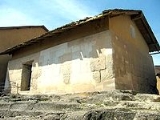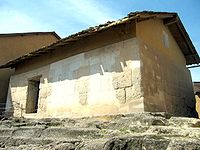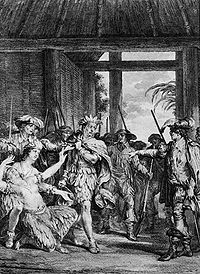
Ransom Room
Encyclopedia

Cajamarca
Cajamarca may refer to:Colombia*Cajamarca, Tolima a town and municipality in Tolima DepartmentPeru* Cajamarca, city in Peru.* Cajamarca District, district in the Cajamarca province.* Cajamarca Province, province in the Cajamarca region....
, Peru
Peru
Peru , officially the Republic of Peru , is a country in western South America. It is bordered on the north by Ecuador and Colombia, on the east by Brazil, on the southeast by Bolivia, on the south by Chile, and on the west by the Pacific Ocean....
. It is considered by most Peruvian historians to be the place where the Inca Empire
Inca Empire
The Inca Empire, or Inka Empire , was the largest empire in pre-Columbian America. The administrative, political and military center of the empire was located in Cusco in modern-day Peru. The Inca civilization arose from the highlands of Peru sometime in the early 13th century...
came to an end with the capture and eventual execution of the Inca Emperor Atahualpa
Atahualpa
Atahualpa, Atahuallpa, Atabalipa, or Atawallpa , was the last Sapa Inca or sovereign emperor of the Tahuantinsuyu, or the Inca Empire, prior to the Spanish conquest of Peru...
.
When Francisco Pizarro
Francisco Pizarro
Francisco Pizarro González, Marquess was a Spanish conquistador, conqueror of the Incan Empire, and founder of Lima, the modern-day capital of the Republic of Peru.-Early life:...
arrived in Cajamarca on November 15, 1532, he sent a messenger to Atahualpa, proposing they both meet outside the Main Plaza. Soon after, Atahualpa agreed and decided to come out but did not reach the place Pizarro asked for, so as to let the Spaniards approach him and his faithful nobles for the meeting. At this point Pizarro decided to send a friar, Vicente de Valverde, along with an interpreter (Felipillo
Felipillo
Felipillo was a native Peruvian who accompanied Francisco Pizarro and Diego de Almagro on their various expeditions to Peru. Born on the Island of Puná, Felipillo learned Quechua in Tumbes from natives who spoke it as a second language...
) to speak with Atahualpa. Friar Valverde presented himself to Atahualpa as a man of God
God
God is the English name given to a singular being in theistic and deistic religions who is either the sole deity in monotheism, or a single deity in polytheism....
, and explained through the interpreter the mysteries of Catholic
Catholic
The word catholic comes from the Greek phrase , meaning "on the whole," "according to the whole" or "in general", and is a combination of the Greek words meaning "about" and meaning "whole"...
religion, and that, on account of their heathenism, the pope had granted his kingdom to the Spaniards. Atahualpa professed not to understand the tenor of this discourse, and would not resign his kingdom, saying he would "be no man's tributary." Upon hearing this, the friar is said to have given a Bible
Bible
The Bible refers to any one of the collections of the primary religious texts of Judaism and Christianity. There is no common version of the Bible, as the individual books , their contents and their order vary among denominations...
to Atahualpa, who, after merely observing it and turning a few pages, threw the holy book on the floor since he had no knowledge of Christianity
Christianity
Christianity is a monotheistic religion based on the life and teachings of Jesus as presented in canonical gospels and other New Testament writings...
and did not seem to care (The Inca probably didn't have the concepts necessary to be able to discern what writing, let alone a book, was. The throwing of the book has been attributed as a saving of face in light of his confusion (a divine emperor can't afford to look confused).). Instead, Atahualpa demanded a full account of the presence of the Spaniards in his land.
The friar, however, did not take any further actions and merely picked up the Bible and left to inform Pizarro of the incident, calling Atahualpa a "dog" and full of pride. He also told Pizarro he suspected the fields around the plaza where the Spaniards were hiding were soon to be invaded by Indians to look for them. At this point Pizarro assessed the situation had come to take over the Main Square by force and he, along with the Spaniards who had been hiding in the surroundings of the square, decided to come out on horseback
Cavalry
Cavalry or horsemen were soldiers or warriors who fought mounted on horseback. Cavalry were historically the third oldest and the most mobile of the combat arms...
with firearm
Firearm
A firearm is a weapon that launches one, or many, projectile at high velocity through confined burning of a propellant. This subsonic burning process is technically known as deflagration, as opposed to supersonic combustion known as a detonation. In older firearms, the propellant was typically...
s, causing many of Atahualpa's army to flee upon hearing the sounds of artillery and muskets.

Thereafter, Pizarro went on to look for Atahualpa himself, who was surrounded and shielded by his faithful nobles, who, in the end, were also captured by the Spaniards. Most of the Nobles were killed for committing crimes and protecting the emperor.

Huáscar
Huáscar Inca was Sapa Inca of the Inca empire from 1527 to 1532 AD, succeeding his father Huayna Capac and brother Ninan Cuyochi, both of whom died of smallpox while campaigning near Quito.After the conquest, the Spanish put forth the idea that Huayna Capac may have...
, who he thought was an obstacle to his ruling of the empire. Atahualpa gave these orders thinking the Spaniards would soon leave after further concessions, leaving him ruling alone once again.
Pizarro and the Spanish decided to charge Atahualpa with 12 crimes, the most important being attempting to revolt against the Spanish, practicing idolatry
Idolatry
Idolatry is a pejorative term for the worship of an idol, a physical object such as a cult image, as a god, or practices believed to verge on worship, such as giving undue honour and regard to created forms other than God. In all the Abrahamic religions idolatry is strongly forbidden, although...
and murdering Huascar
Huáscar
Huáscar Inca was Sapa Inca of the Inca empire from 1527 to 1532 AD, succeeding his father Huayna Capac and brother Ninan Cuyochi, both of whom died of smallpox while campaigning near Quito.After the conquest, the Spanish put forth the idea that Huayna Capac may have...
, his own brother. Atahualpa was found guilty of all 12 charges, and was sentenced to execution by burning. Atahualpa realized the Spaniards' greed and offered Pizarro to buy his liberty by filling the room where he was kept prisoner with gold
Gold
Gold is a chemical element with the symbol Au and an atomic number of 79. Gold is a dense, soft, shiny, malleable and ductile metal. Pure gold has a bright yellow color and luster traditionally considered attractive, which it maintains without oxidizing in air or water. Chemically, gold is a...
and the two following rooms with silver
Silver
Silver is a metallic chemical element with the chemical symbol Ag and atomic number 47. A soft, white, lustrous transition metal, it has the highest electrical conductivity of any element and the highest thermal conductivity of any metal...
, up to the level of the reach of his arm. After being led to the place of execution, Atahualpa begged for his life. Friar Vicente de Valverde, who before had offered the Bible to Atahualpa, intervened again, telling Atahualpa that if he agreed to convert to Christianity he would persuade the rest to commute his sentence. Atahualpa agreed to be baptized into the Christian faith and, in the end, was strangled instead of being burned
Execution by burning
Death by burning is death brought about by combustion. As a form of capital punishment, burning has a long history as a method in crimes such as treason, heresy, and witchcraft....
,
or rather was strangled just before being burned: this was the mercy the Inquisition
Inquisition
The Inquisition, Inquisitio Haereticae Pravitatis , was the "fight against heretics" by several institutions within the justice-system of the Roman Catholic Church. It started in the 12th century, with the introduction of torture in the persecution of heresy...
granted to heretics that repented of their heresy. Atahualpa died on August 29, 1533.
It is noteworthy that various sources claim the so-called "ransom room" alleged to have been filled with gold was only where Atahualpa was held prisoner, and the real room filled with gold was located at an unconfirmed location .
After Atahualpa was executed, the "Tahuantinsuyo" (Inca Empire)
Inca Empire
The Inca Empire, or Inka Empire , was the largest empire in pre-Columbian America. The administrative, political and military center of the empire was located in Cusco in modern-day Peru. The Inca civilization arose from the highlands of Peru sometime in the early 13th century...
is considered to have reached its end, giving way to the further Spanish conquest of Peru. During 2004, approximately 60,000 tourists visited the site of the ransom room in Cajamarca, Peru .

